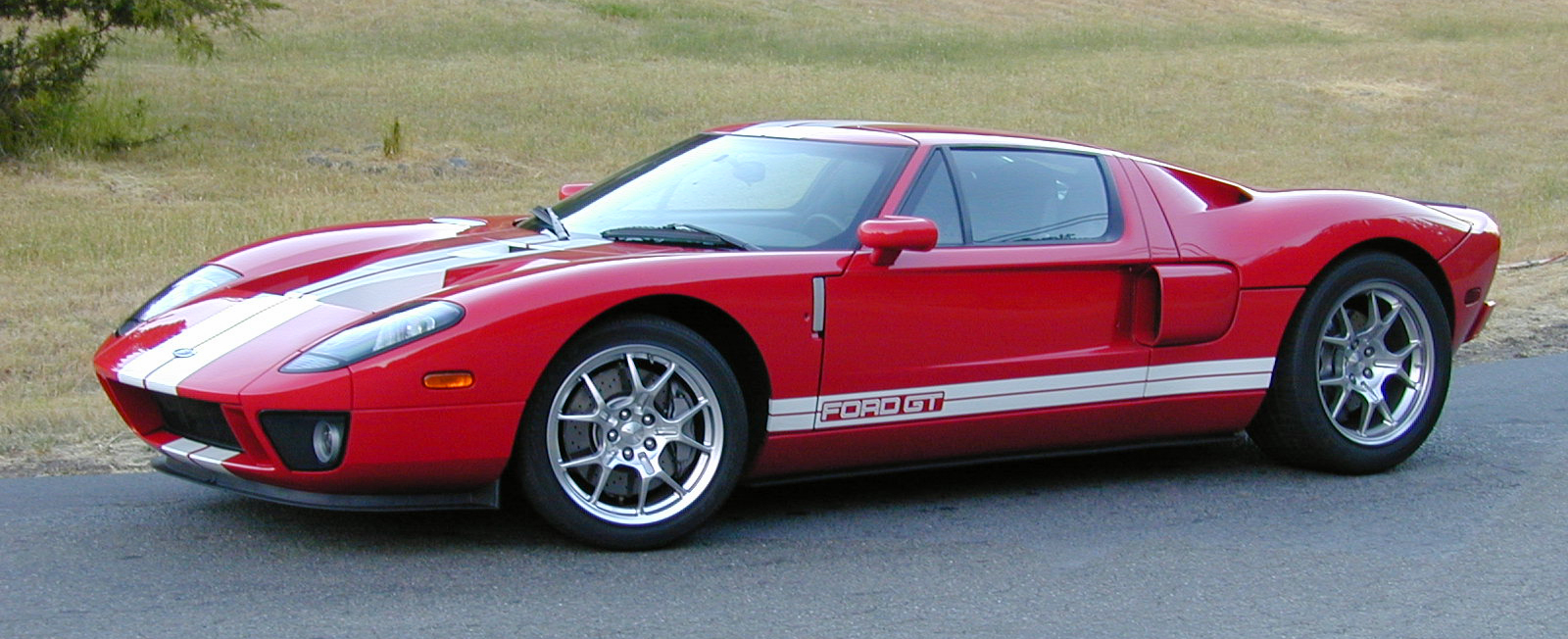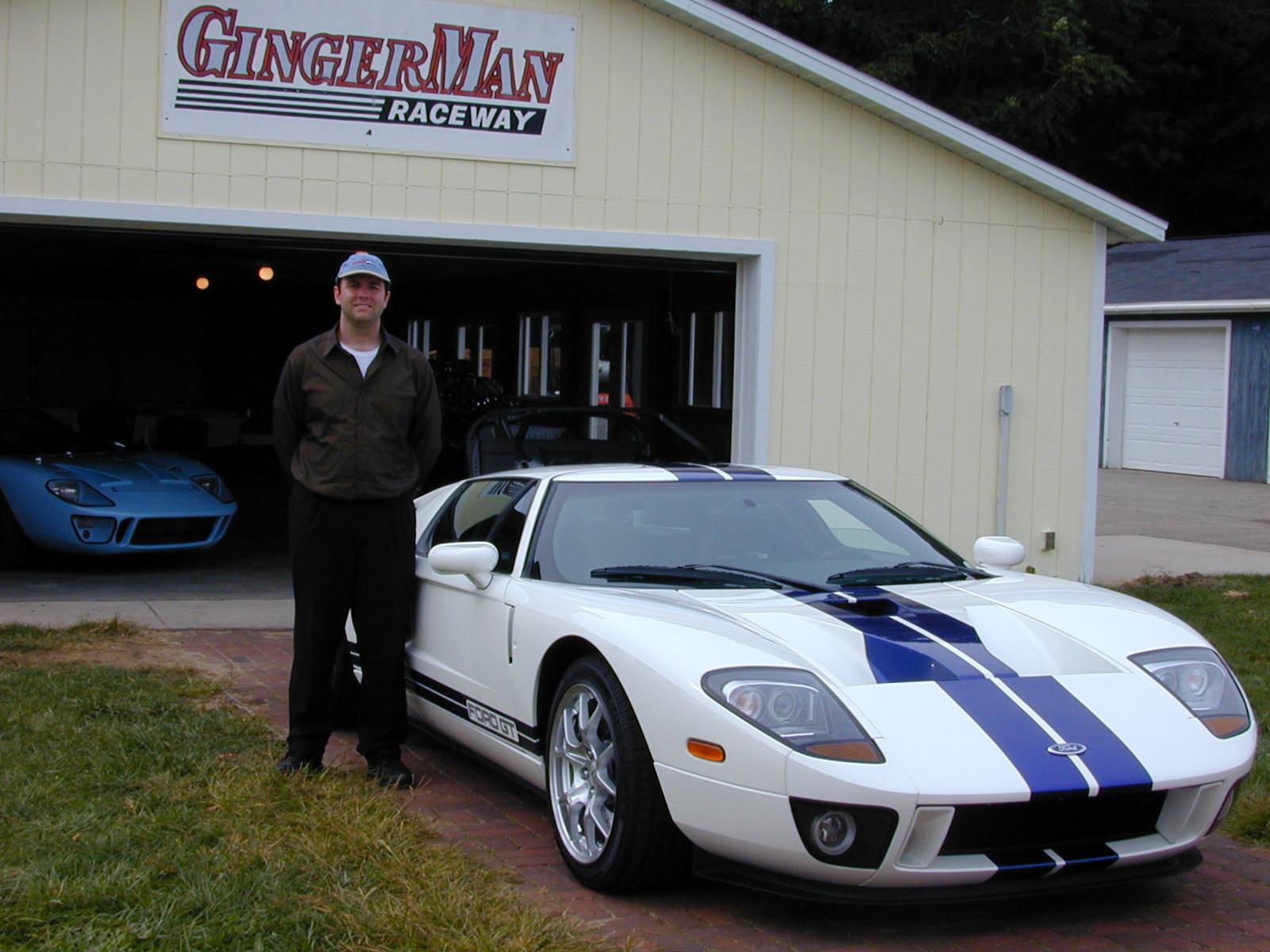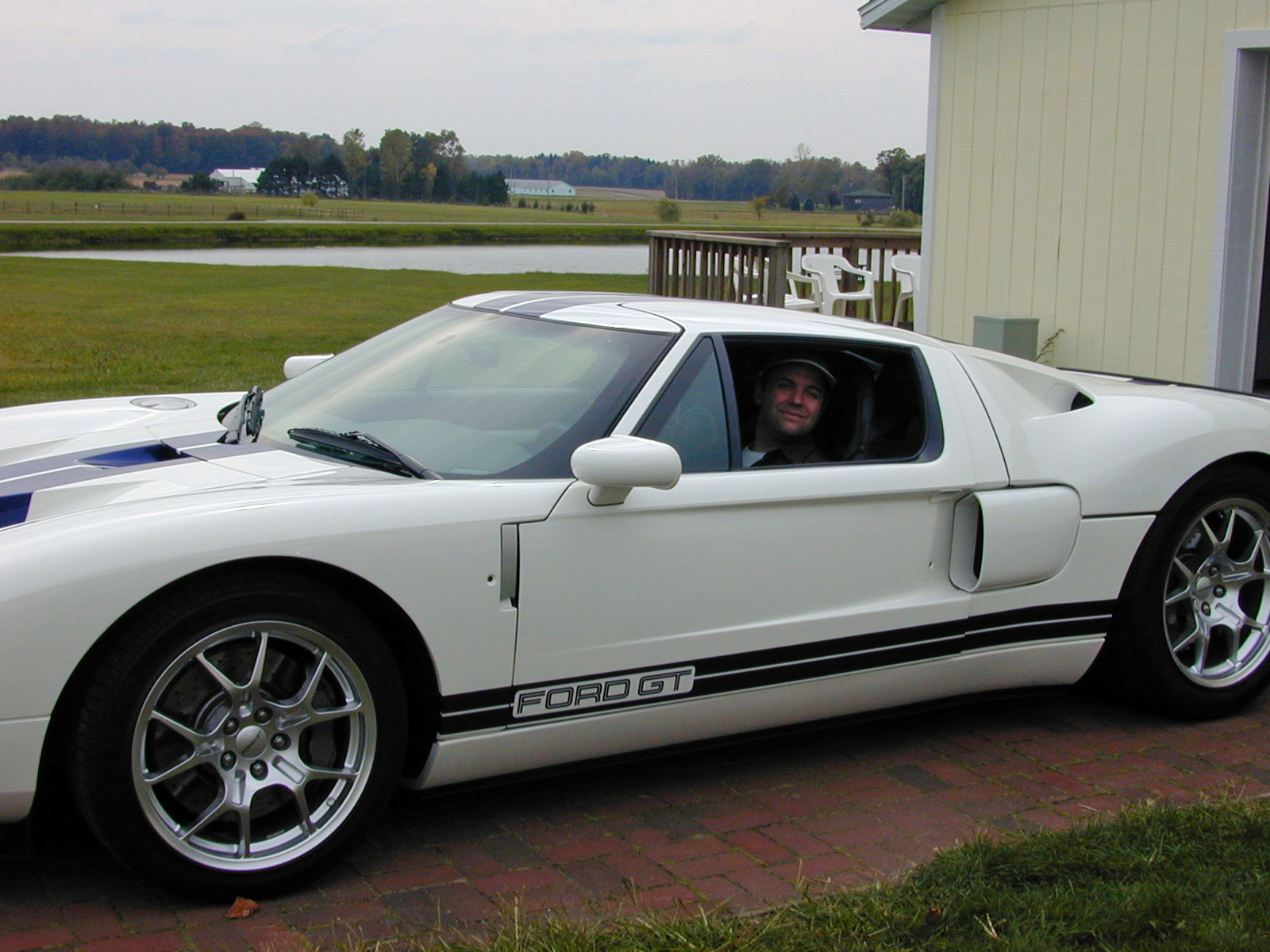By October 2003 it had been almost 2 years since the Ford GT40 concept debuted at the 2002 Detroit Auto Show. At this point GT enthusiasts knew the car would be called the “GT” and not “GT40” due to a legal battle with Safir GT40 Spares (a company that owned the rights to the term). We also knew the car was suffering delays in development. Challenges related to the Ford GT’s paint process, central fuel tank and aluminum suspension pieces had delayed its production, though three prototype versions of the GT (one red, one white, and one blue), were presented in June of 2003 at Ford’s Centennial Celebration.
Those three prototypes, dubbed 2004 Ford GTs, were one-off models used to engineer the final 2005 production versions. Their prototype nature made them worth over a million dollars, each, and the white one also happened to be Bill Ford Jr’s personal car. I didn’t know if I’d ever get to drive these prototypes, but then my primary Ford GT contact, Alan Hall, called to say I could drive them (except Bill’s) at Gingerman Raceway, a track in Western Michigan. I actually had a prior commitment in Las Vegas the night before, which meant a red-eye flight to Detroit, followed by a 3-hour drive from Detroit Metro Airport to Gingerman Raceway. Ford was kind enough to leave me a Ford SVT Focus at the airport, but I was running on empty when I got to the track. Thankfully, the sight of multiple Ford GTs racing around Gingerman instantly restored me to peak energy. This was the first time I’d seen the GT outside a static show display.
Multiple media outlets were at the track that day, including Car and Driver. The magazine had corralled a then-new Ferrari 360 Modena, the model Ford used as a benchmark for the Ford GT’s performance goals. Car and Driver didn’t give Ford any notice about the Ferrari coming to Gingerman Raceway, but the Blue Oval guys weren’t worried when it showed up. Why would they be — the engineering team had possession of a 360 Modena throughout the Ford GT’s development. They already knew what would happen when the two tangled on the track.
I’ll never forget my first seat time in that red 2005 Ford GT. Driving Gingerman Raceway with Tom Reichenbach (the GT’s vehicle engineering manager) in the passenger seat was genuinely bizarre. First, the car was far better than I expected it to be. I had confidence Ford could make a car capable of beating the Ferrari 360 Modena in terms of raw performance numbers (which they did, with room to spare), but I honestly didn’t expect the Ford to drive better than the Ferrari. Happily, I was dead wrong. Within one lap on the track I was drifting the GT’s rear end while counter-steering out of corners.
Keep in mind the value of those three 2004 Ford GT prototypes (a silver, early 2005 prototype was also at the track). If I wrecked one of them I would be destroying a valuable test vehicle not easily replaced. Yet here I was, power-sliding the car within minutes of getting behind the wheel. Why? Not because I’m a big risk taker in other people’s three-off prototypes. In fact, I tend to be more conservative than many of my colleagues, even when driving regular production press cars. But the Ford GT was so good I didn’t feel remotely close to its limits as I roared around Gingerman Raceway. Tom Reichenbach didn’t seem to mind either. “You and one other journalist had a good eye for the course. You did a good job. The rest of them were a little timid” he told me when we finished our lap time. The car was truly amazing, making me want one even more…but I still had no assurance Ford could help me get one, creating a likely bidding battle with every other Ford GT fanatic (most of whom would be better financed). Anyway, here’s my first drive road test, based on this event, that originally published on October 28th, 2003:
First Drive: 2005 Ford GT
Ford is officially referring to 2005 as the “year of the car” because that’s the year it plans to re-engage the American consumer with great product – great product that doesn’t necessarily feature body-on-frame construction. The company has a long history of producing compelling trucks and SUVs, but Ford officials will readily admit they’ve neglected the car side of the product lineup for the last decade.
While not every new car to wear a Blue Oval is going to be as exciting as the 2005 Ford GT, the folks in Dearborn feel like this vehicle accurately represents their commitment to setting new benchmarks in design, quality and value – regardless of price point. And whereas most Fords will continue to compete with Chrysler, GM, Honda, Toyota and other mainstream automakers, this one has its sights set on a niche car company from Italy, just like it did 40 years ago with the original GT40.
While the exterior shape is obviously driven by the 1960s-era GT40 that defeated Ferrari at Le Mans, the design and structure of the vehicle is all new, and its development utilized pure 21st-century technology. Now that it’s here and I’ve driven it, I can confirm that Ford has met its own expectations, as well as those of likely GT customers.
I was fortunate enough to drive the GT at a closed-course race facility where its capabilities could effectively be explored. It was here I learned what will define this vehicle in a class that includes the Porsche 911 GT2, Ferrari 360 Modena and Lamborghini Gallardo. That defining element is the GT’s uncompromised performance mated to unmatched drivability. Though world-class capabilities are expected of any vehicle in this market segment (the GT’s pricing has yet to be revealed, but think $135,000 to $150,000), that level of performance often comes with a darker side. In the case of cars like the 360 Modena and Porsche 911 GT2, you must also possess world-class driving skills to access the upper limits of their performance envelopes. (Actually, you can access those limits no matter what your skill set, but your insurance agent – for both life and auto – will likely hear about it).
In contrast to the razor’s edge one must walk when driving aggressively in the Ferrari or Porsche, Ford has built a vehicle that can outrun either model without the accompanying potential for twisted aluminum and broken carbon fiber. I discovered this after driving the second- and third-production Ford GTs built. These were the same cars that participated in the company’s recent 100th anniversary celebration, and they represent two-thirds of the total Ford GT production run for 2004 (car number one is owned by Bill Ford Jr.).
Needless to say, these two cars are rather unique and valuable, so you’d have to be a real idiot to drift them through turns and/or slide the massive 315/40ZR19 Goodyear rear tires when exiting corners. Maybe that’s one way I could describe the GT: “Makes normally responsible people drive like idiots.” A more accurate statement is that the GT’s limits are easily accessed due to its ultrastiff aluminum frame (more bending resistance than the 360 Modena), advanced suspension design (also aluminum with unequal-length upper “A” arms front and rear) and powerful engine (a supercharged 5.4-liter aluminum-block V8 with 500 peak horsepower). These features are tied together by a rack-and-pinion steering system, Ricardo six-speed manual transmission and Brembo cross-drilled rotors (14-inch rotors up front, 13.2 inches in back) with ABS. An antilock brake system happens to be the only modern-day driving aid you’ll find on the GT, not that I missed traction or stability control in the least.
Perhaps the biggest challenge faced by the GT team was fitting a contemporary supercar under a 1960s shell. The new GT is considerably larger than the original version (18 inches longer, 4 inches higher), but that original car had issues that were intrinsic to its shape as well as its size. Simply making the new GT bigger fixed many issues within the passenger compartment, yet it did little to address the original car’s inherent aerodynamic failings. But extensive computer modeling and wind tunnel testing allowed the team to retain the original GT40’s shape while keeping the modern version stable up to its nearly 200-mph top speed. A key element in achieving this involved using underbody splitters that are visible when viewing the car from the rear. The car will come in several colors that include blue, red, silver, white, yellow and even the original Gulf Racing livery worn by the 1966 Le Mans winners (trademark issues might keep Ford from using “Gulf” in the sales literature.
Getting into the GT without suffering bodily injury requires patience and concentration. The trademark “door flows into roof” design of 40 years ago still looks great, yet it’s anything but practical. The engineers did their best to accommodate real people, few of whom had to deal with the original car’s entry-exit challenges. The doors open to nearly 90 degrees – assuming there’s room next to the car to swing them that far – and once out of the way there’s plenty of clearance to avoid the upper edges. The GT’s cabin accurately captures the essence of its progenitor with ventilated seats, dash-mounted toggle switches and a large tachometer front and center (the speedometer is off to the right). An optional McIntosh audio system and center-mounted speaker between the seat backs ensure that the supercharged V8 won’t be the only sonic stimulation available.
Speaking of superchargers, the Lysholm unit that sits atop the midmounted engine is literally inches from your head when seated in the GT. Turn to look at your passenger and it’s difficult not to notice the spinning belt on the other side of the rear glass. Rear visibility is poor, as with any midengine car, though Ford is still working on exterior mirror placement and A-pillar thickness to give drivers as much rearward vision as possible. The company is also tweaking seat bottom support, steering wheel adjustment range and interior materials in an effort to offer the maximum amount of comfort and quality. Between the tilt-telescoping steering wheel and driver-oriented shifter, it was easy to find a comfortable driving position, but headroom was relatively tight for my six-foot frame (wearing a helmet didn’t help matters, but even without it there wouldn’t have been a lot of room between my head and the roof — which at that point is actually the door).
But whining about headroom or ease of entry in a vehicle like the Ford GT is like getting bent out of shape because the supermodel you’re dating causes everyone to stop and stare when you enter a restaurant. Aren’t these factors part of the reason you begin such a relationship in the first place? By the time we were sliding the GT’s rear end and basking in its relentless torque curve, we had forgotten all about the challenges of getting in and out of it. The car’s inherent stability makes a C5 Corvette feel skittish by comparison. The steering and clutch operate with minimal effort while providing subtle feedback and inspiring confidence. The exhaust tone could be bit throatier, but the V8 still sounds amazing, especially when the revs jump during shifts. Ford engineers noted that today’s noise standards give them little room to maneuver in this area.
If there was one area I never fully acclimated to during our brief seat time, it was the braking system. I was constantly applying too much pressure too early when slowing for a turn. The 14-inch Brembo rotors grab like fresh Velcro and, combined with the massive front tire contact patches, they haul the GT down from speed with Formula One-like authority. They aren’t grabby or difficult to modulate, they just offer far more power than I expected, even by supercar standards.
Rumor has it a GT has already beaten a 911 GT2 and 360 Modena’s lap times in back-to-back track testing. Even if the numbers are close, we’re certain the Porsche and Ferrari drivers had to work much harder than the GT driver to get each car’s best lap times. Plenty of exotic car owners would consider such a statement a badge of honor, but for my money I’ll take the kind of all-access performance offered by the GT. At least the Ford’s confident nature means I’ll have a free hand to wave at the Ferraris and Porsches as I pass by.




